Energy Efficiency in Buildings: The Gap Between Energy Certification Methods and Real Performances
Abstract
1. Introduction
2. Energy Performance Certificate in the EU
3. Limits of Building Energy Simulation for EPC
3.1. Overview of the Main Sources of Discrepancy in Energy Simulation
- the lack of precise information about input parameters such as the thermo-physical data of envelope components;
- calculation limits of the tool used to describe the geometric features (e.g., in the presence of thermal bridges and a heat flow model restricted to one-dimensional flow);
- the adoption of inaccurate or incomplete models of certain physical phenomena (e.g., the capability to model the vapour and water transfer through the building envelope components, etc.).
3.2. Performance Gap Comparison Between QSS and DS Methods
3.3. The Cooling Demand Paradox
3.4. Main Issues to Overcome
- different resolution of weather data (average monthly values used in the quasi-steady state method cannot capture the effects of climatic variations over time);
- estimation of solar and thermal gains in the quasi-steady state method results in significant deviations in the building’s energy performance;
- the dynamic properties of a building and their effect on the building’s energy performance are modelled with quasi-steady state methods using empirically determined gain utilization factors, which approximate the results of cooling energy demand;
- a fixed air set-point temperature is used in the quasi-steady state methods for the whole calculation period, whereas intermittent heating and/or cooling is treated as continuous with adjusted set-point temperature;
- scheduling the infiltration/ventilation rate is not possible in the quasi-steady state method.
4. Case-Study Description
5. Energy Assessment Procedure
5.1. Calibration and Validation of the DS Energy Model
5.2. Simulation A—QSS Simulation with Standard Boundary Conditions
5.3. Simulation B—DS Simulation with Tailored Boundary Conditions
5.4. Simulation C—DS Simulation with Standard Boundary Conditions
- weather file (WF): rather than utilizing the hourly weather file (TMY 2000–2009), the monthly average conditions are adopted as fixed values;
- ground temperature (GT): instead of using temperature profiles provided in the EPW file related to Milano, the equivalent ground temperature estimated from the heat flow calculated through UNI EN ISO 13370 in the quasi-steady state method is adopted. It should be noted that such derived temperatures are usually higher than the one provided in the EPW used in the dynamic simulation;
- user profile (UP): rather than using a detailed tailored profile, a fixed daily average value is applied for the whole year.
| Parameter | Unit of Measure | Real Building/ Model Calibration | Simulation A: QSS Simulation (Standard) | Simulation B: DS Simulation (Tailored) | Simulation C: DS Simulation (Standard) |
|---|---|---|---|---|---|
| simulation tool | - | - | Termolog | EnergyPlus | EnergyPlus |
| climate data | various | measured climatic data from 2006 (downloaded from ARPA [58]) | standard average monthly data | hourly data from Milan TMY 2000–2009 | standard average monthly data |
| heating degree days (HDDs) | - | 2403 | 2404 | 2272 | 2404 |
| cooling degree days (CDDs) | - | 472 | 366 | 462 | 366 |
| ground temperature | °C | / | estimated monthly profile | monthly measured profile provided in the weather file | estimated monthly profile |
| internal gains due to people, electrical equipment and artificial lighting | W/m2 h/day days/year | 19.7 14 261 (1.3–2.7 W/m2 for the remaining time) | 6 24 365 | 20 10 261 (2 W/m2 for the remaining time) | 6 24 365 |
| infiltration + ventilation | h−1 | 0.9 | 0.72 | 0.72 | 0.72 |
| h/day | 14 | 8 | 8 | 8 | |
| days/year | 365 | 365 | 365 | 365 | |
| heating | °C | 20 | 20 | 20 | 20 |
| h/day | 24 | 24 | 24 | 24 | |
| days/year | 15 October to 15 April | 15 October to 15 April | 15 October to 15 April | 15 October to 15 April | |
| cooling | °C h/day days/year | 26 depending on the space request | 26 depending on the space request | 26 depending on the space request | 26 depending on the space request |
6. Results and Discussion
7. Conclusions
- adopting DS simulation makes it possible to account for the mutual interactions between the building, occupants and the external boundary conditions;
- from the perspective of increasing temperatures due to climate change, there is a preference in the use of dynamic simulations and to update the reference weather file for estimating energy consumption, avoiding the use of weather data that includes too outdated climate datasets;
- providing more detailed user profiles for appliances, lighting and occupancy, instead of relying on constant average values throughout the year, enables obtaining a more precise estimation of energy demand (and thus energy consumption);
- the DS method offers superior capabilities in accounting for building envelope properties, such as heat capacity, and their impacts on energy performance. In contrast, the QSS method approximates these effects through utilization factors, resulting in less accurate results;
- in recent years, the introduction of new standards based on the hourly calculation method has improved the accessibility, transparency and reliability of dynamic simulations by minimizing user input while shifting complexity to standardized procedures and robust software capable of detailed, consistent calculations;
- although model calibration enhances the accuracy of dynamic simulations, its application within large-scale EPC frameworks is impractical due to excessive data requirements, computational costs and user expertise demands. A more viable approach involves employing dynamic simulations with standardized and tailored boundary conditions and usage profiles, which maintain methodological consistency and realism while ensuring scalability and operational feasibility.
Author Contributions
Funding
Data Availability Statement
Conflicts of Interest
Abbreviations
| EPBD | Energy Performance of Buildings Directive |
| EPC | Energy-Performance Certificate |
| QSS | Quasi-steady state |
| DS | Dynamic state |
| TMY | Typical Meteorological Year |
| U-value | Thermal transmittance |
| Umod | U-value modified |
| SHGC | Solar Heat Gain Coefficient |
| τv | Visible Transmittance |
| ACH | Air Changes per Hour |
| HDDs | Heating Degree Days |
| CDDs | Cooling Degree Days |
| NMBE | Normalized Mean Bias Error |
| CVRMSE | Coefficient of Variation of the Root Mean Square Error |
| ARPA | Agenzia Regionale per la Protezione dell’Ambiente |
| Taverage | Average exterior temperature |
| Tmax | Maximum exterior temperature |
References
- Berardi, U. A Cross-Country Comparison of the Building Energy Consumptions and Their Trends. Resour. Conserv. Recycl. 2017, 123, 230–241. [Google Scholar] [CrossRef]
- European Parliament and the Council of the Union Directive 2023/1791 of the European Parliament and of the Council of 13 September 2023. Off. J. Eur. Union 2023, 231, 1–111. Available online: https://data.europa.eu/eli/dir/2023/1791/oj (accessed on 8 November 2024).
- Ballarini, I.; Primo, E.; Corrado, V. On the Limits of the Quasi-Steady-State Method to Predict the Energy Performance of Low-Energy Buildings. Therm. Sci. 2018, 2018, 1117–1127. [Google Scholar] [CrossRef]
- Pretelli, M.; Fabbri, K. Historic Indoor Microclimate of the Heritage Buildings, Pretelli, M. ed; Springer: Cham, Swizerland, 2018; ISBN 978-3-319-60341-4. [Google Scholar]
- Menezes, A.C.; Cripps, A.; Bouchlaghem, D.; Buswell, R. Predicted vs. Actual Energy Performance of Non-Domestic Buildings: Using Post-Occupancy Evaluation Data to Reduce the Performance Gap. Appl. Energy 2012, 97, 355–364. [Google Scholar] [CrossRef]
- De Wilde, P. The Gap between Predicted and Measured Energy Performance of Buildings: A Framework for Investigation. Autom. Constr. 2014, 41, 40–49. [Google Scholar] [CrossRef]
- Bruno, R.; Bevilacqua, P.; Arcuri, N. Assessing Cooling Energy Demands with the EN ISO 52016-1 Quasi-Steady Approach in the Mediterranean Area. J. Build. Eng. 2019, 24, 100740. [Google Scholar] [CrossRef]
- Domjan, S.; Arkar, C.; Begelj, Ž.; Medved, S. Evolution of All-Glass Nearly Zero Energy Buildings with Respect to the Local Climate and Free-Cooling Techniques. Build. Environ. 2019, 160, 106183. [Google Scholar] [CrossRef]
- Corrado, V.; Enrico, F. Il Significato del Fattore di Utilizzazione Nel Calcolo Semplificato del Fabbisogno Termico degli Edifici: Aspetti Teorici e Applicativi; AICARR: Bologna Italy; Torino, Italy; Napoli, Italy, 2008. [Google Scholar]
- Van Dijk, D.; Spiekman, M. EN ISO 52016 and 52017: Calculation of the building’s energy needs for heating and cooling, internal temperatures and heating and cooling load. REHVA J. 2016, 53, 27–30. Available online: https://www.rehva.eu/rehva-journal/chapter/en-iso-52016-and-52017-calculation-of-the-buildings-energy-needs-for-heating-and-cooling-internal-temperatures-and-heating-and-cooling-load (accessed on 8 November 2024).
- Van Dijk, D. EPB standards: Why choose hourly calculation procedures? REHVA J. 2018, 55, 6–12. Available online: https://www.rehva.eu/rehva-journal/chapter/epb-standards-why-choose-hourly-calculation-procedures (accessed on 8 November 2024).
- Zakula, T.; Bagaric, M.; Ferdelji, N.; Milovanovic, B.; Mudrinic, S.; Ritosa, K. Comparison of Dynamic Simulations and the ISO 52016 Standard for the Assessment of Building Energy Performance. Appl. Energy 2019, 254, 113553. [Google Scholar] [CrossRef]
- Beccali, M.; Mazzarella, L.; Motta, M. Simplified Models for Building Cooling Energy Requirement; International Building Performance Simulation Association: Rio de Janeiro, Brazil, 2001; Volume 7, pp. 295–302. [Google Scholar]
- Kotarela, F.; Kyritsis, A.; Agathokleous, R.; Papanikolaou, N. On the Exploitation of Dynamic Simulations for the Design of Buildings Energy Systems. Energy 2023, 271, 127002. [Google Scholar] [CrossRef]
- European Parliament and the Council of the Union. Directive 2002/91/EC of the European Parliament and of the Council of 16 December 2002 on the Energy Performance of Buildings. Off. J. Eur. Union 2002. Available online: http://data.europa.eu/eli/dir/2002/91/oj (accessed on 8 November 2024).
- Recast, E. Directive 2010/31/EU of the European Parliament and of the Council of 19 May 2010 on the Energy Performance of Buildings (Recast). Off. J. Eur. Union 2010, 18, 2010. Available online: http://data.europa.eu/eli/dir/2010/31/oj (accessed on 8 November 2024).
- Jenkins, D.P.; Sayfikar, M.; Gomez, A.; Fueyo, N. A Comparative Study of Energy Performance Certificates across Europe. Buildings 2024, 14, 2906. [Google Scholar] [CrossRef]
- Akkurt, G.G.; Aste, N.; Borderon, J.; Buda, A.; Calzolari, M.; Chung, D.; Costanzo, V.; Del Pero, C.; Evola, G.; Huerto-Cardenas, H.E.; et al. Dynamic Thermal and Hygrometric Simulation of Historical Buildings: Critical Factors and Possible Solutions. Renew. Sustain. Energy Rev. 2020, 118, 109509. [Google Scholar] [CrossRef]
- Macdonald, I.A. Quantifying the Effects of Uncertainty in Building Simulation. Ph.D. Thesis, University of Strathclyde, Glasgow, UK, 2002. [Google Scholar]
- van Dronkelaar, C.; Dowson, M.; Spataru, C.; Mumovic, D. A Review of the Regulatory Energy Performance Gap and Its Underlying Causes in Non-Domestic Buildings. Front. Mech. Eng. 2016, 1, 17. [Google Scholar] [CrossRef]
- Costantino, A.; Ballarini, I.; Fabrizio, E. Comparison Between Simplified and Detailed Methods for the Calculation of Heating and Cooling Energy Needs of Livestock Housing: A Case Study; Free University of Bozen Bolzano: Bolzano, Italy, 2017. [Google Scholar]
- Van der Veken, J.; Saelens, D.; Verbeeck, G.; Hens, H. Comparison of Steady-State and Dynamic Building Energy Simulation Programs; ACEEE: Washington, DC, USA, 2004. [Google Scholar]
- Corrado, V.; Ballarini, I.; Dirutigliano, D.; Murano, G. Verification of the New Ministerial Decree about Minimum Requirements for the Energy Performance of Buildings. Energy Procedia 2016, 101, 200–207. [Google Scholar] [CrossRef]
- Zhang, S.; Liu, Y.; Yang, L.; Liu, J.; Hou, L.Q. Applicability of Different Energy Efficiency Calculation Methods of Residential Buildings in Severe Cold and Cold Zones of China. IOP Conf. Ser. Earth Environ. Sci. 2019, 238, 012029. [Google Scholar] [CrossRef]
- Evangelisti, L.; Battista, G.; Guattari, C.; Basilicata, C.; de Vollaro, R.L. Analysis of Two Models for Evaluating the Energy Performance of Different Buildings. Sustainability 2014, 6, 5311–5321. [Google Scholar] [CrossRef]
- Schito, E.; Testi, D.; Conti, P.; Grassi, W. Validation of Seas, a Quasi-Steady-State Tool for Building Energy Audits. Energy Procedia 2015, 78, 3192–3197. [Google Scholar] [CrossRef]
- Pernigotto, G.; Gasparella, A. Quasi-Steady State and Dynamic Simulation Approaches for the Calculation of Building Energy Needs: Part 2 Thermal Gains; Bozen-Bolzano University Press: Bolzano, Italy, 2013. [Google Scholar]
- EN ISO 13790:2008; Energy Performance of Buildings—Calculation of Energy Use for Space Heating and Cooling. European Committee for Standardization (CEN): Brussels, Belgium, 2008.
- Zangheri, P.; Armani, R.; Pietrobon, M.; Pagliano, L.; Fernandez Boneta, M.; Müller, A. Heating and Cooling Energy Demand and Loads for Building Types in Different Countries of the EU; D2.3. of WP2 of the Entranze Project; Polytechnic University of Turin: Turin, Italy, 2014; p. 86. [Google Scholar]
- Calise, F.; Cappiello, F.L.; Cimmino, L.; Vicidomini, M. Semi-Stationary and Dynamic Simulation Models: A Critical Comparison of the Energy and Economic Savings for the Energy Refurbishment of Buildings. Energy 2024, 300, 131618. [Google Scholar] [CrossRef]
- Magrini, A.; Lentini, G. NZEB Analyses by Means of Dynamic Simulation and Experimental Monitoring in Mediterranean Climate. Energies 2020, 13, 4784. [Google Scholar] [CrossRef]
- Bruno, R.; Arcuri, N.; Carpino, C. Cooling Energy Needs in Non-Residential Buildings Located in Mediterranean Area: A Revision of the Quasi-Steady Procedure; Universita Della Calabria: Arcavacata, Italy, 2017. [Google Scholar]
- Bruno, R.; Arcuri, N.; Carpino, C. Study of Innovative Solutions of the Building Envelope for Passive Houses in Mediterranean Areas. Energy Procedia 2017, 140, 80–92. [Google Scholar] [CrossRef]
- Detommaso, M.; Evola, G.; Gagliano, A.; Marletta, L.; Nocera, F. Thermal Performance of Innovative Building Envelope Systems in Mediterranean Climate. In Proceedings of the Building Simulation Applications BSA 2017; Bolzano University Press: Bolzano, Italy, 2017; pp. 77–85. [Google Scholar]
- Corrado, V.; Ballarini, I.; Paduos, S.; Primo, E. The Energy Performance Assessment of nZEBs: Limitations of the Quasi-Steady State Approach; Aalborg University: Copenhagen, Denmark, 2016. [Google Scholar]
- Fokaides, P.A.; Maxoulis, C.N.; Panayiotou, G.P.; Neophytou, M.K.-A.; Kalogirou, S.A. Comparison between Measured and Calculated Energy Performance for Dwellings in a Summer Dominant Environment. Energy Build. 2011, 43, 3099–3105. [Google Scholar] [CrossRef]
- Zavrl, M.Š.; Stegnar, G. Comparison of Simulated and Monitored Energy Performance Indicators on NZEB Case Study Eco Silver House. Procedia Environ. Sci. 2017, 38, 52–59. [Google Scholar] [CrossRef]
- Kang, Y.; Ma, N.; Bunster, V.; Chang, V.W.; Zhou, J. Optimizing the Passive House Planning Package Simulation Tool: A Bottom-up Dynamic Approach to Reduce Building Performance Gap. Energy Build. 2022, 276, 112512. [Google Scholar] [CrossRef]
- Kokogiannakis, G.; Strachan, P.; Clarke, J. Comparison of the Simplified Methods of the ISO 13790 Standard and Detailed Modelling Programs in a Regulatory Context. J. Build. Perform. Simul. 2008, 1, 209–219. [Google Scholar] [CrossRef]
- Wauman, B.; Breesch, H.; Saelens, D. Evaluation of the Accuracy of the Implementation of Dynamic Effects in the Quasi Steady-State Calculation Method for School Buildings. Energy Build. 2013, 65, 173–184. [Google Scholar] [CrossRef]
- Jradi, M. Dynamic Energy Modelling as an Alternative Approach for Reducing Performance Gaps in Retrofitted Schools in Denmark. Appl. Sci. 2020, 10, 7862. [Google Scholar] [CrossRef]
- Simanic, B.; Nordquist, B.; Bagge, H.; Johansson, D. Predicted and Measured User-Related Energy Usage in Newly Built Low-Energy Schools in Sweden. J. Build. Eng. 2020, 29, 101142. [Google Scholar] [CrossRef]
- Palladino, D.; Iatauro, D.; Signoretti, P. Application of Hourly Dynamic Method for nZEB Buildings in Italian Context: Analysis and Comparisons in National Calculation Procedure Framework. E3S Web Conf. 2021, 312, 02006. [Google Scholar] [CrossRef]
- Oliveti, G.; Arcuri, N.; Bruno, R.; De Simone, M. An Accurate Calculation Model of Solar Heat Gain through Glazed Surfaces. Energy Build. 2011, 43, 269–274. [Google Scholar] [CrossRef]
- EN ISO 52016-1:2017; Energy Performance of Buildings-Energy Needs for Heating and Cooling, Internal Temperatures and Sensible and Latent Heat Loads. European Committee for Standardization (CEN): Brussels, Belgium, 2017.
- Van Dijk, D.; Spiekman, M.; Orshoven, D.V.; Plokker, W. Subset of EPB Standards on the Energy Use and the Thermal Performance of Buildings and Building Elements. REHVA J. 2015, 52, 6–16. Available online: https://www.rehva.eu/fileadmin/REHVA_Journal/REHVA_Journal_2015/RJ_issue_1/P.06/06-16_RJ1501_WEB.pdf (accessed on 8 November 2024).
- Van Dijk, D.; Spiekman, M.; Van Oeffelen, L.H. EPB Standard EN ISO 52016_Calculation of the Building’s Energy Needs for Heating and Cooling, Internal Temperatures and Heating and Cooling Load. REHVA J. 2016, 53, 18–22. Available online: https://www.rehva.eu/rehva-journal/chapter/epb-standard-en-iso-52016-calculation-of-the-buildings-energy-needs-for-heating-and-cooling-internal-temperatures-and-heating-and-cooling-load (accessed on 8 November 2024).
- Aste, N.; Del Pero, C. Energy Retrofit of Commercial Buildings: Case Study and Applied Methodology. Energy Effic. 2013, 6, 407–423. [Google Scholar] [CrossRef]
- Aste, N.; Adhikari, R.S.; Del Pero, C.; Tagliabue, L.C. Energy Retrofit of Commercial Buildings: A Case Study on ERGO Building. In Proceedings of the 7th International Conference on Energy Efficiency in Commercial Buildings IEECB’12, Frankfurt, Germany, 18–19 April 2012; pp. 392–401. [Google Scholar]
- EN 15603:2008; Energy Performance of Buildings—Overall Energy Use and Definition of Energy Ratings. iTeh Standards: Brussels, Belgium, 2008.
- Huerto-Cardenas, H.E. Validation of Historical Buildings Energy Models: A Method Based on Microclimatic Control Parameters. Ph.D. Thesis. Politecnico di Milano, Milan, Italy, 2020. [Google Scholar]
- Hargan, M.R. ANSI/ASHRAE ASHRAE Guideline 14-2002 Measurement of Energy and Demand Savings; ASHRAE: Peachtree Corners, GA, USA, 2002; p. 170. [Google Scholar]
- UNI/TS 11300-1:2014; Prestazioni Energetiche degli Edifici—Parte 1: Determinazione DEL Fabbisogno di Energia Termica Dell’edificio per la Climatizzazione Estiva Ed Invernale. Ente Nazionale Italiano di Unificazione (UNI): Milano, Italy, 2014.
- Logical Soft Termolog. Available online: https://logical.it/software-termotecnica (accessed on 8 November 2024).
- Regione Lombardia, D.d.u.o. 18 Dicembre 2019—n.18546. Aggiornamento Delle Disposizioni per l’efficienza Energetica degli Edifici Approvate Con Decreto n. 2456 Del 8 Marzo 2017. 2019. Available online: https://www.anit.it/wp-content/uploads/2020/01/Decreto_18546-2019.pdf (accessed on 8 November 2024).
- U.S. Department of Energy. EnergyPlus Essentials 2021. Available online: https://www.energy.gov/eere/buildings/articles/energyplus (accessed on 8 November 2024).
- UNI 10339:1995; Impianti Aeraulici al Fini Di Benessere. Generalità, Classificazione e Requisiti. Regole per La Richiesta d’offerta, l’offerta, l’ordine e la Fornitura. Ente Nazionale Italiano di Unificazione (UNI): Milano, Italy, 1995.
- ARPA. Richiesta Dati Misurati; ARPA Lombardia: Milano, Italy, 2020. [Google Scholar]

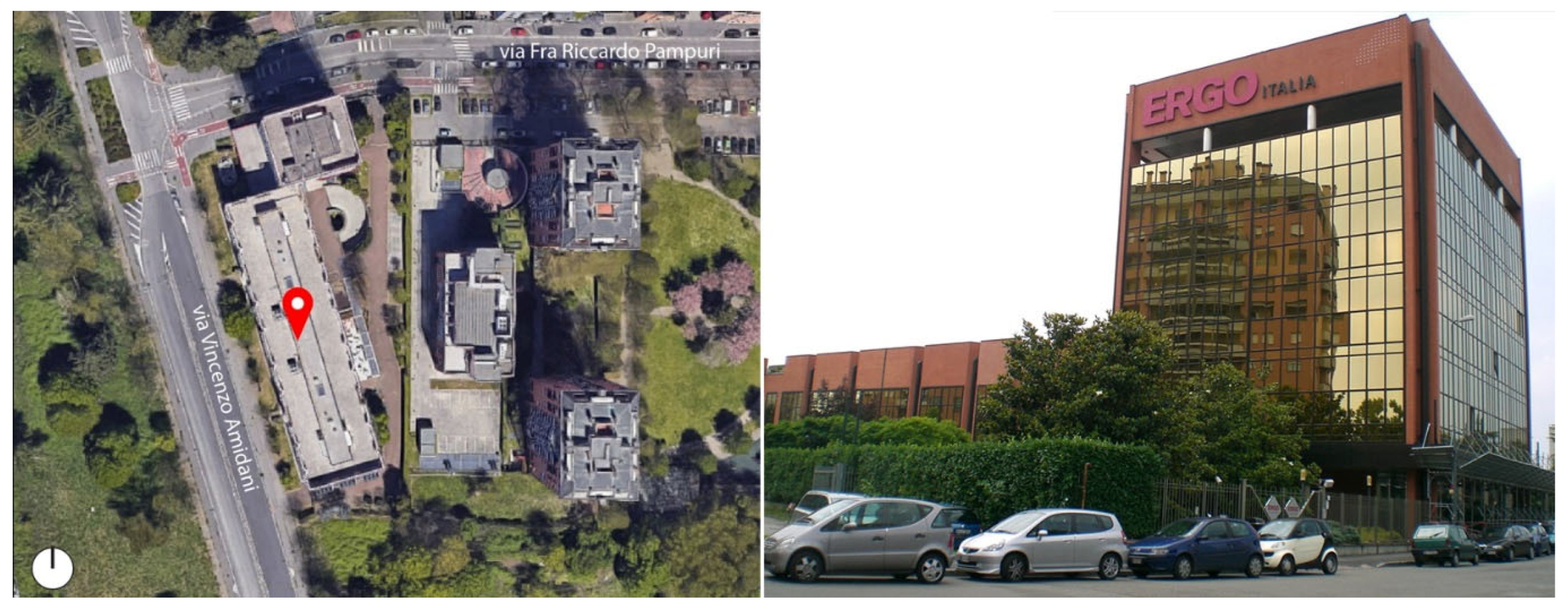

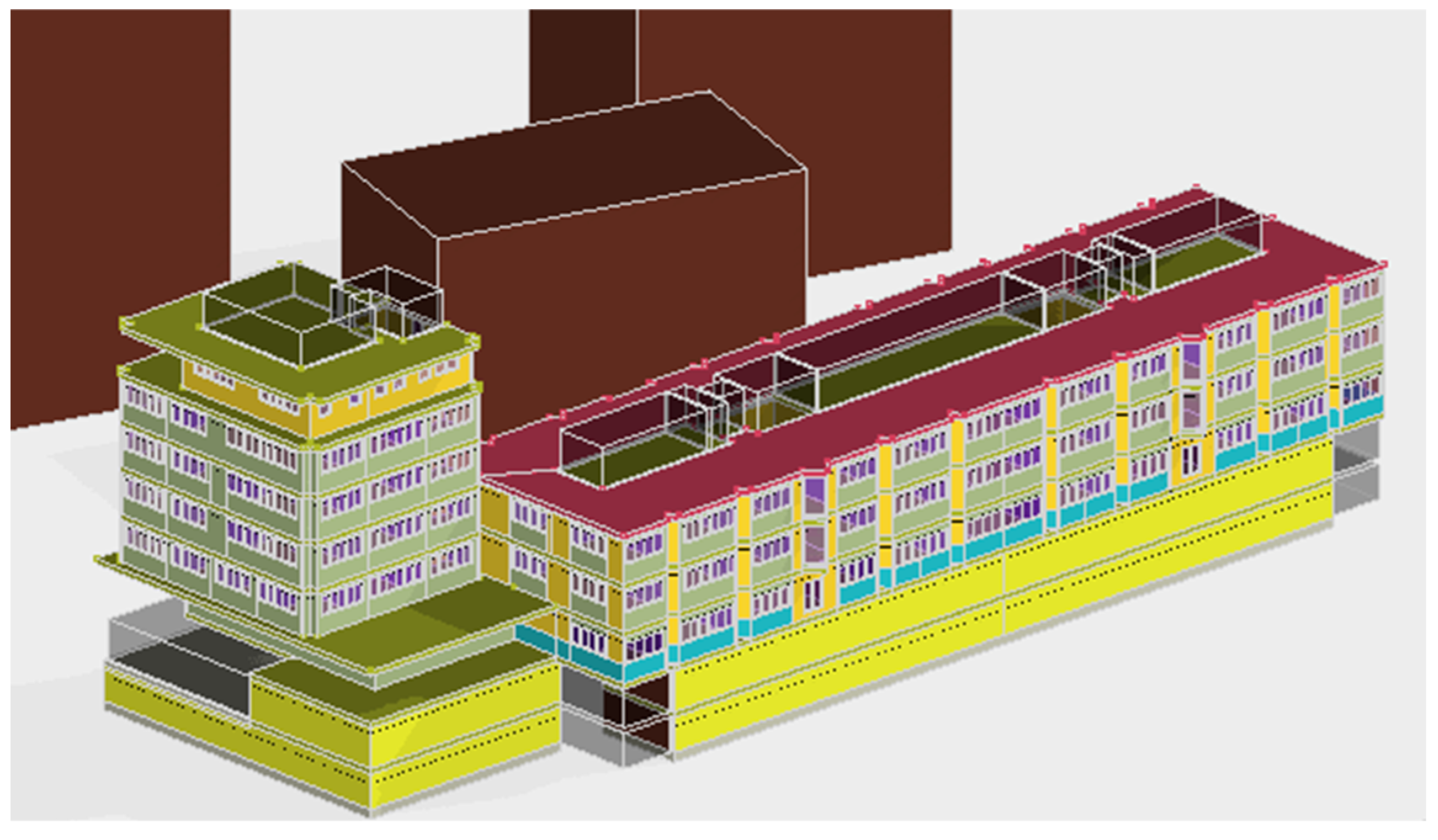
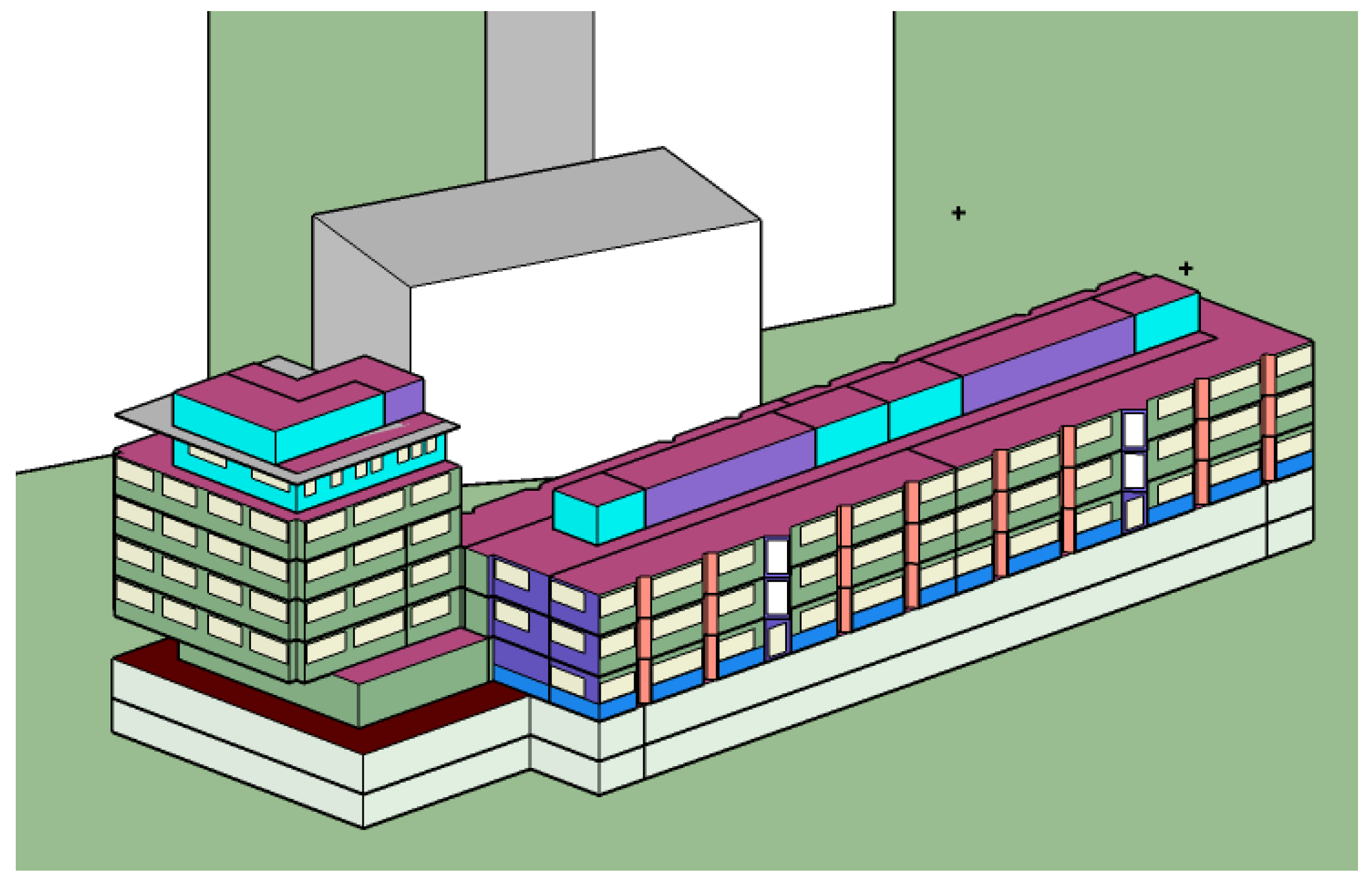
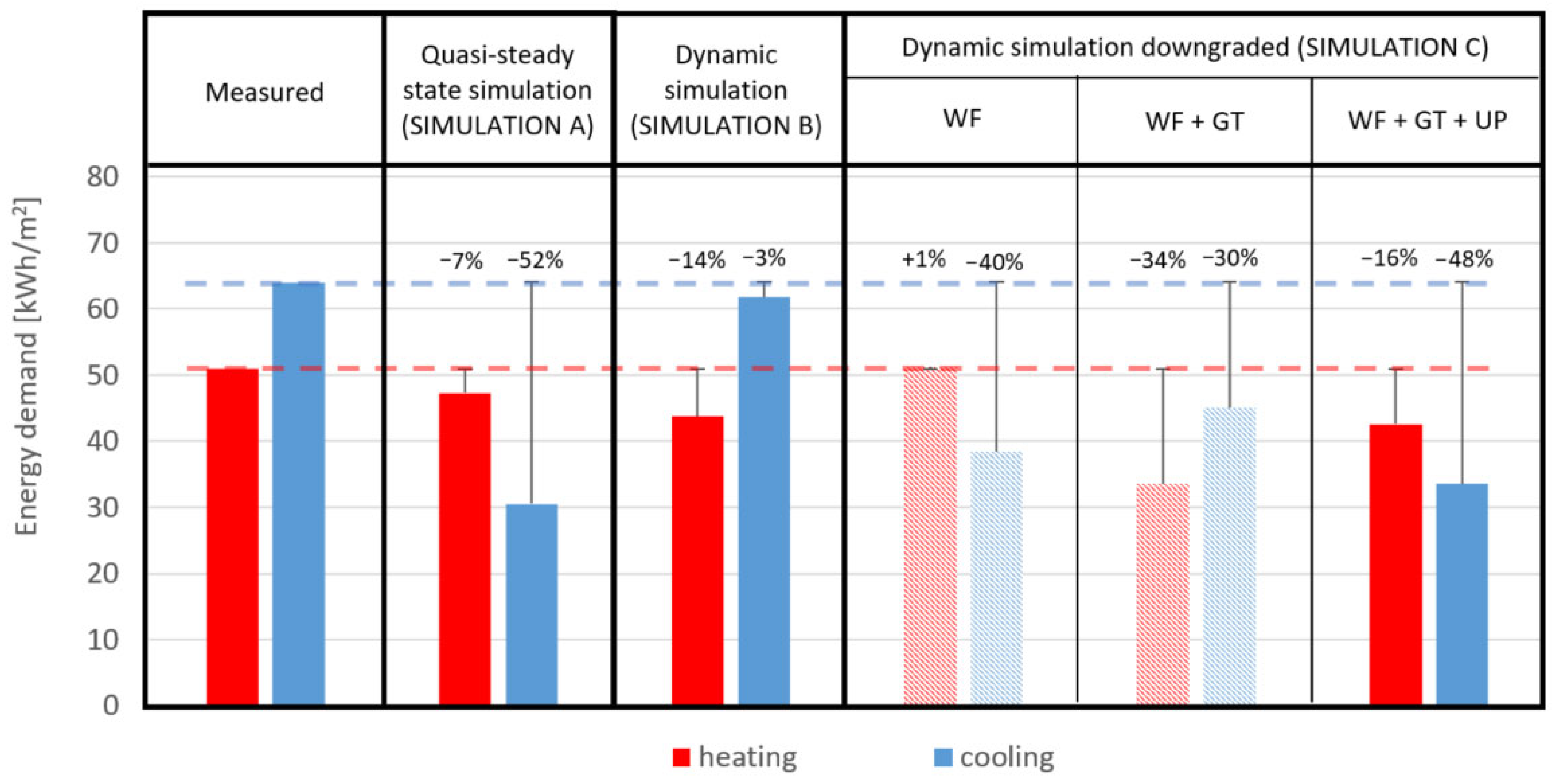
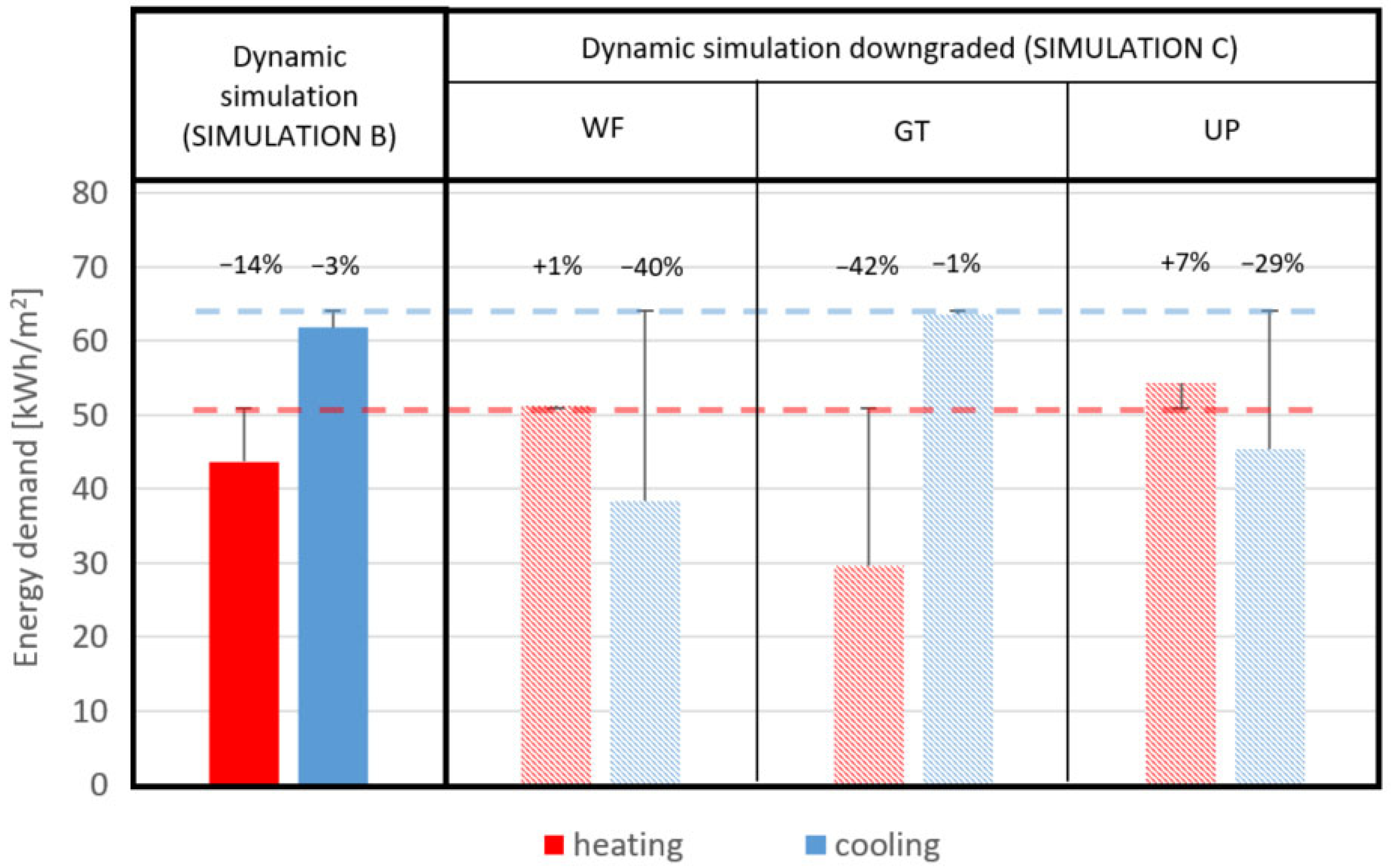
| Country | Capital City | Tmax [°C] | Taverage [°C] | Latitude |
|---|---|---|---|---|
| Austria | Vien | 31.40 | 21.82 | 48.19 |
| Belgium | Brüssel | 30.50 | 17.83 | 50.90 |
| Bulgaria | Sofia | 37.00 | 20.43 | 42.69 |
| Croatia | Zagreb | 37.10 | 22.59 | 45.81 |
| Republic of Cyprus | Nicosia | 42.10 | 30.13 | 35.15 |
| Czech Republic | Prague | 31.80 | 19.09 | 50.06 |
| Denmark | Kopenaghen | 27.90 | 16.93 | 55.61 |
| Estonia | Tallin | 27.00 | 16.11 | 59.41 |
| Finland | Helsinki | 23.60 | 17.47 | 60.17 |
| France | Paris | 32.30 | 20.03 | 48.82 |
| Germany | Berlin | 28.50 | 17.89 | 52.46 |
| Greece | Athen | 38.00 | 27.61 | 37.91 |
| Hungary | Budapest | 30.00 | 20.09 | 47.51 |
| Ireland | Dublin | 21.90 | 15.26 | 53.42 |
| Italy | Rome | 31.80 | 24.24 | 41.90 |
| Latvia | Riga | 27.40 | 17.16 | 56.95 |
| Lithuania | Vilnius | 29.70 | 17.21 | 54.63 |
| Malta | La Valletta | 27.60 | 25.79 | 35.85 |
| Netherlands | Amsterdam | 26.10 | 17.79 | 52.31 |
| Poland | Warsaw | 33.20 | 16.60 | 52.25 |
| Portugal | Lisbon | 34.70 | 22.88 | 38.71 |
| Romania | Bucharest | 37.00 | 23.98 | 44.41 |
| Slovakia | Bratislava | 33.60 | 22.07 | 48.16 |
| Slovenia | Ljubjana | 35.50 | 20.77 | 46.06 |
| Spain | Madrid | 39.20 | 25.59 | 40.45 |
| Sweden | Stockholm | 29.50 | 18.20 | 59.35 |
| Main Building Information | ||
|---|---|---|
| average U-value Light walls|Massive walls|Roof | 0.47 W/m2K|0.94 W/m2K|0.48 W/m2K | |
| glazing U-value|SHGC|τv | 1.8 W/m2K|0.35|0.28 | |
| thermal heat load for electrical equipment|artificial lighting | 10.3 W/m2|9.4 W/m2 | |
| Air Changes per Hour (ACH) | 0.9 h−1 for 14 h per day | |
| Technical System Efficiencies | ||
| summer period | winter period | |
| emission average efficiency | 0.85 | 0.85 |
| control average efficiency | 0.90 | 0.90 |
| distribution average efficiency | 0.95 | 0.95 |
| generation average efficiency/COP | 2.53 | 0.85 |
| global average seasonal efficiency/COP | 1.84 | 0.62 |
Disclaimer/Publisher’s Note: The statements, opinions and data contained in all publications are solely those of the individual author(s) and contributor(s) and not of MDPI and/or the editor(s). MDPI and/or the editor(s) disclaim responsibility for any injury to people or property resulting from any ideas, methods, instructions or products referred to in the content. |
© 2025 by the authors. Licensee MDPI, Basel, Switzerland. This article is an open access article distributed under the terms and conditions of the Creative Commons Attribution (CC BY) license (https://creativecommons.org/licenses/by/4.0/).
Share and Cite
Aste, N.; Huerto-Cardenas, H.E.; Pero, C.D.; Leonforte, F.; Buzzetti, M.; Adhikari, R.S.; Montevecchio, E.; Blavier, C.L.S. Energy Efficiency in Buildings: The Gap Between Energy Certification Methods and Real Performances. Energies 2025, 18, 6015. https://doi.org/10.3390/en18226015
Aste N, Huerto-Cardenas HE, Pero CD, Leonforte F, Buzzetti M, Adhikari RS, Montevecchio E, Blavier CLS. Energy Efficiency in Buildings: The Gap Between Energy Certification Methods and Real Performances. Energies. 2025; 18(22):6015. https://doi.org/10.3390/en18226015
Chicago/Turabian StyleAste, Niccolò, Harold Enrique Huerto-Cardenas, Claudio Del Pero, Fabrizio Leonforte, Michela Buzzetti, Rajendra Singh Adhikari, Elisa Montevecchio, and Camille Luna Stella Blavier. 2025. "Energy Efficiency in Buildings: The Gap Between Energy Certification Methods and Real Performances" Energies 18, no. 22: 6015. https://doi.org/10.3390/en18226015
APA StyleAste, N., Huerto-Cardenas, H. E., Pero, C. D., Leonforte, F., Buzzetti, M., Adhikari, R. S., Montevecchio, E., & Blavier, C. L. S. (2025). Energy Efficiency in Buildings: The Gap Between Energy Certification Methods and Real Performances. Energies, 18(22), 6015. https://doi.org/10.3390/en18226015












